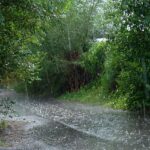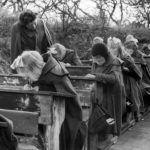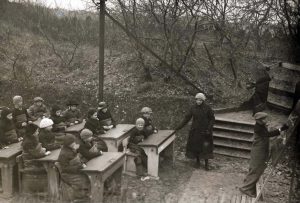bacteria

 After it rains, most of us notice a distinctive refreshing smell that lingers in the air for a while. The strange thing is that most of the time, we didn’t notice that there was a bad odor in the air, but when we walk through a rainstorm, or just step outside after it has rained, slowly hits us…that fresh, earthy smell. There is no way to say exactly what it smells like, because it’s a smell like no other smell I know…it just smells like rain. Strangely, before it hits the ground, rain is just water. It has no smell at all.
After it rains, most of us notice a distinctive refreshing smell that lingers in the air for a while. The strange thing is that most of the time, we didn’t notice that there was a bad odor in the air, but when we walk through a rainstorm, or just step outside after it has rained, slowly hits us…that fresh, earthy smell. There is no way to say exactly what it smells like, because it’s a smell like no other smell I know…it just smells like rain. Strangely, before it hits the ground, rain is just water. It has no smell at all.
The big change happens after it hits the ground, and it might shock you to find out what the cause of that wonderful transformation actually is. After the drops hit the ground and interact with dirt, the fresh and almost sweet fragrance of rain is let go. Now, as near as the scientists have been able to determine, they believe they’ve identified the exact mechanism that releases this aroma into the environment. The smell actually has a name. It’s called “Petrichor” and comes from the Greek words “Petra” or “stone” and “ichor” or a fluid that flows like blood in veins. The phenomenon was first characterized (as the familiar smell after a light rain) by two Australian scientists in 1964, but until now, researchers didn’t understand the physical mechanism behind it.
There are actually several causes for this, and this is where it gets a little…well, creepy…maybe. The most common is a bacteria called Actinomycetes, which is a filamentous type of bacteria that’s smells more strongly in woodland or areas with soil where it grows when it’s damp and warm. When the bacteria dries, spores are produced and that is what we can smell, because the force of the rainfall disperses the spores into the air, rather like an aerosol air freshener. The smell produced by these spores is a kind of earthy, refreshing smell. It’s most noticeable when it rains after a long spell of dryness, but will still occur after most instances of rainfall. Now, I suppose we could become grossed out, but there is nothing we can do about it, so we might as well just enjoy the smell. Besides that, there are bacteria, spores, and pollen in the air we breathe all the time, so it’s not like this is some “new assault” on our systems. There are also more triggers for smells after 
 rainstorms. One such trigger is acidity caused by chemicals in the atmosphere, which mostly occurs in heavy urban areas. Another smell that’s common and very similar to actinomycetes, and has even been bottled and sold, is from the evaporative oils that plants and trees produce. That probably doesn’t turn our stomachs quite as much, so if the idea of bacteria bothers you, just make up your mind to believe that the smell comes from evaporative plant oils, and you should feel better about it.
rainstorms. One such trigger is acidity caused by chemicals in the atmosphere, which mostly occurs in heavy urban areas. Another smell that’s common and very similar to actinomycetes, and has even been bottled and sold, is from the evaporative oils that plants and trees produce. That probably doesn’t turn our stomachs quite as much, so if the idea of bacteria bothers you, just make up your mind to believe that the smell comes from evaporative plant oils, and you should feel better about it.

 Most people have heard of “flesh-eating infections” caused by group A Streptococcus, scientifically known as Streptococcus Pyogenes. These days, these are the big headline grabbing diseases, but 150 years ago, the biggest headline grabber was Scarlet Fever. Whenever people heard of this disease, their blood ran cold. During the Victorian era in the United States and Europe. Scarlet fever killed United States children in the 1920s, 1930s and 1940s. Of the children who contracted the disease, thousands died.
Most people have heard of “flesh-eating infections” caused by group A Streptococcus, scientifically known as Streptococcus Pyogenes. These days, these are the big headline grabbing diseases, but 150 years ago, the biggest headline grabber was Scarlet Fever. Whenever people heard of this disease, their blood ran cold. During the Victorian era in the United States and Europe. Scarlet fever killed United States children in the 1920s, 1930s and 1940s. Of the children who contracted the disease, thousands died.
It was in about 1949 that my mother, Collene Byer Spencer contracted the disease. It was still a terrifying situation for the family. My grandparents had nine children, and having one get Scarlet Fever put the rest of the children in danger too. Scarlet Fever can cause long-term complications as a result of Scarlet Fever include kidney disease, rheumatic heart disease, and arthritis. Following my mom’s bout with Scarlet Fever, she developed a heart murmur that she did not have prior to the disease. She was sick a long time, and in reality, they almost lost her. She spent a long period of time delirious from the fever, barely knowing anything that was going on around her. Even after she recovered, it would be a number of years before she had much strength. Her hearing suffered from the Scarlet Fever too. She could hear, but she had such a ringing in her ears that it made hearing the words being spoken to her very difficult. I have not heard that any of her siblings caught the disease, so I think they must have quarantined mom from the others during the disease.
The bacterial infection that causes Scarlet Fever often starts with strep throat and skin infections. Certain strep  bacteria produce a toxin that can cause a red rash—the “scarlet” of scarlet fever. Scarlet fever is usually a mild illness that most commonly affects children between 5 and 15 years old…these days. The streptococcus bacteria that caused strep throat infections were genetically different than the strains around today, and they could cause children to become very sick and die. In years gone by, the schools implemented throat cultures to detect strep throat before it could develop into Scarlet Fever. A few years back, they stopped that because they thought it was wiped out. As a mom who did throat cultures, that makes me nervous. Such a simple test to protect from such an awful disease, and such a simple medicine…Penicillin to get rid of it, was a no brainer.
bacteria produce a toxin that can cause a red rash—the “scarlet” of scarlet fever. Scarlet fever is usually a mild illness that most commonly affects children between 5 and 15 years old…these days. The streptococcus bacteria that caused strep throat infections were genetically different than the strains around today, and they could cause children to become very sick and die. In years gone by, the schools implemented throat cultures to detect strep throat before it could develop into Scarlet Fever. A few years back, they stopped that because they thought it was wiped out. As a mom who did throat cultures, that makes me nervous. Such a simple test to protect from such an awful disease, and such a simple medicine…Penicillin to get rid of it, was a no brainer.
 Tuberculosis was a disease that brought terror to the hearts of people over the years…especially right after World War II, but even before World War II, being diagnosed with Tuberculosis was like being given a death sentence. People had to be quarantined, so they wouldn’t infect those around them, since the disease is airborne. All too often it was too late by the time they knew they needed to be quarantined. Any serious disease can be scary for the people in areas affected, but this one was taken to a completely different level. In an effort to prevent Tuberculosis from being passed from child to child, the schools began a new movement, known as the Open-Air School. The movement required the establishment of schools that combined medical surveillance with A method of learning that was adapted to students with pre-tuberculosis…an obsolete term for the pre-clinical stage of tuberculosis. The new institution was established by doctors researching new prophylactic methods, and educators interested in an open air educational experience.
Tuberculosis was a disease that brought terror to the hearts of people over the years…especially right after World War II, but even before World War II, being diagnosed with Tuberculosis was like being given a death sentence. People had to be quarantined, so they wouldn’t infect those around them, since the disease is airborne. All too often it was too late by the time they knew they needed to be quarantined. Any serious disease can be scary for the people in areas affected, but this one was taken to a completely different level. In an effort to prevent Tuberculosis from being passed from child to child, the schools began a new movement, known as the Open-Air School. The movement required the establishment of schools that combined medical surveillance with A method of learning that was adapted to students with pre-tuberculosis…an obsolete term for the pre-clinical stage of tuberculosis. The new institution was established by doctors researching new prophylactic methods, and educators interested in an open air educational experience.
In 1904, Dr Bernhard Bendix and pedagogue Hermann Neufert founded the first school of this kind: the Waldeschule of Charlottenburg, near Berlin, Germany. Classes were conducted in the woods to offer open-air therapy to young city dwellers with pre-tuberculosis. The experiment, conducted by the International Congresses of Hygiene, was immediately attempted throughout Europe and North America: in Belgium in 1904, in Switzerland, England, Italy, and France in 1907, in the United States in 1908, in Hungary in 1910, and in Sweden in 1914. The schools were called “schools of the woods” or “open air schools.” Often they were remote from cities, set up in tents, prefabricated barracks, or re-purposed structures, and were run during the summer. Some of the more noteworthy experiments were the School in the Sun, in Cergnat, Switzerland and the school of Uffculme near Birmingham, England.  The School of the Sun used helio-therapy in 1910. Dr Auguste Rollier sent the children up to the mountains every morning equipped with portable equipment. The school of Uffculme, noted for its architecture, allowed each class to occupy its own independent pavilion in 1911.
The School of the Sun used helio-therapy in 1910. Dr Auguste Rollier sent the children up to the mountains every morning equipped with portable equipment. The school of Uffculme, noted for its architecture, allowed each class to occupy its own independent pavilion in 1911.
After World War I the movement became organized. The first International Congress took place in Paris in 1922, at the initiative of The League for Open Air Education created in France in 1906, and of its president, Gaston Lemonier. There were four more congresses: in Belgium in 1931; in Germany in 1936, marked by the involvement of German doctor Karl Triebold; in Italy in 1949; and in Switzerland in 1956. National committees were created. Jean Duperthuis, a close associate of Adolphe Ferrière (1879–1960), the well-known pedagogue and theorist of New Education, created the International Bureau of Open Air Schools to collect information on how these schools worked. Testimonies described an educational experience inspired by New Education, with much physical exercise, regular medical checkups, and a closely monitored diet, but there has been little formal study of the majority of these schools.
According to the ideas of the open air school, the architecture had to provide wide access to the outdoors, with large bay windows and a heating system that would permit working with the windows open. The most remarkable of these schools were in Amsterdam, Holland by architect Jan Duiker (1929–1930), in Suresnes, France by Eugène Beaudoin and Marcel Lods (1931–1935), and Copenhagen, Denmark by Kai Gottlob (1935–1938). From what I have seen, most of these school were held completely outdoors. I don’t know if the impact on Tuberculosis was as profound as they had hoped, but there were good things that came out of the  experiments. The movement had an influence on the evolution of education, hygiene, and architecture. School buildings, for example, adopted the concept of classes open to the outdoors, as in Bale, Switzerland (1938–1939, architect Hermann Baur), Impington, England (1939, Walter Gropius and Maxwell Fry), and in Los Angeles (1935, Richard Neutra). This influence is the major contribution of the open air schools movement, although the introduction of antibiotics, which increasingly provided a cure for Tuberculosis, pretty much made them obsolete after World War II. Nevertheless, fresh air, exercise, and playtime for young children have all remained an important part of the school day, and thankfully, Tuberculosis is on the decline, although it still ranks in the top 10 of fatal diseases.
experiments. The movement had an influence on the evolution of education, hygiene, and architecture. School buildings, for example, adopted the concept of classes open to the outdoors, as in Bale, Switzerland (1938–1939, architect Hermann Baur), Impington, England (1939, Walter Gropius and Maxwell Fry), and in Los Angeles (1935, Richard Neutra). This influence is the major contribution of the open air schools movement, although the introduction of antibiotics, which increasingly provided a cure for Tuberculosis, pretty much made them obsolete after World War II. Nevertheless, fresh air, exercise, and playtime for young children have all remained an important part of the school day, and thankfully, Tuberculosis is on the decline, although it still ranks in the top 10 of fatal diseases.

